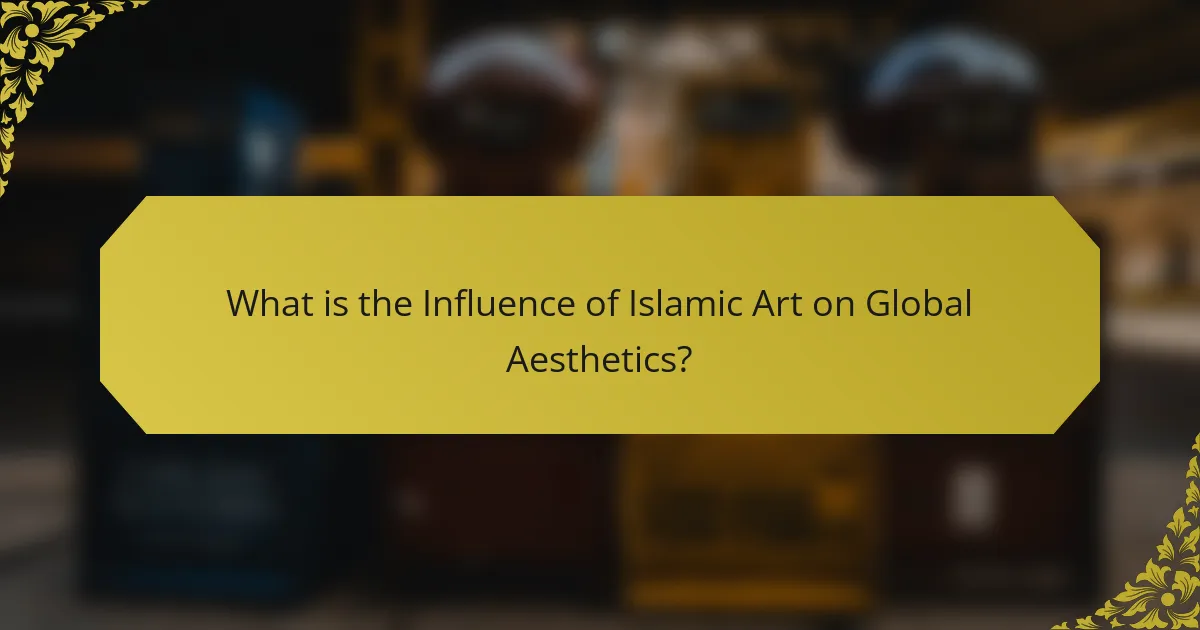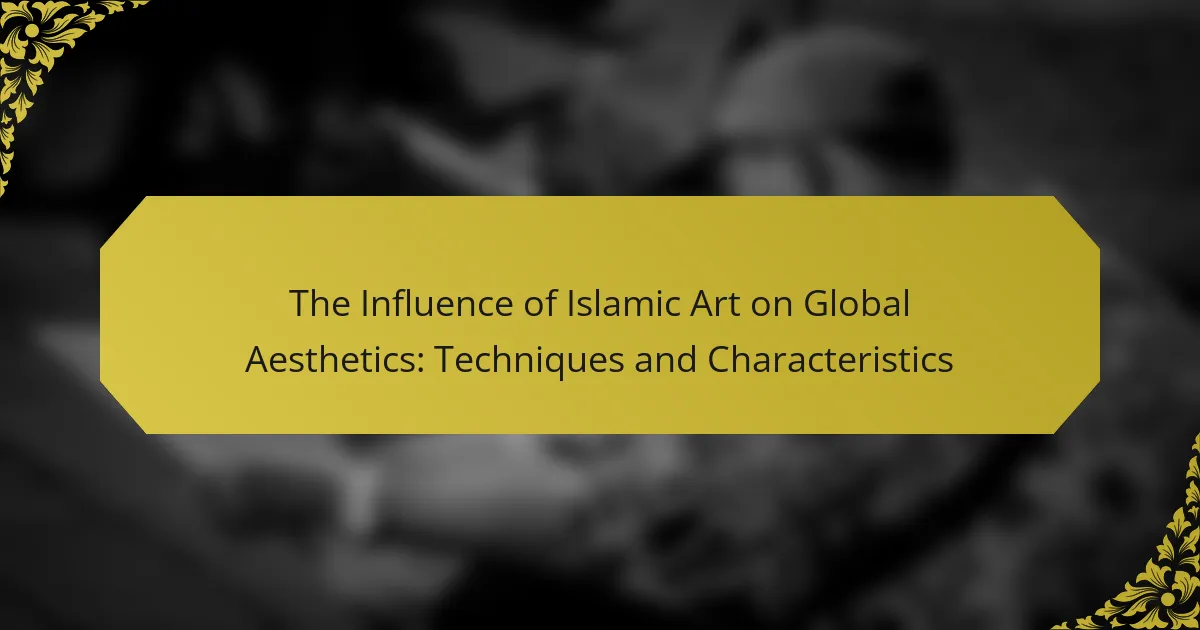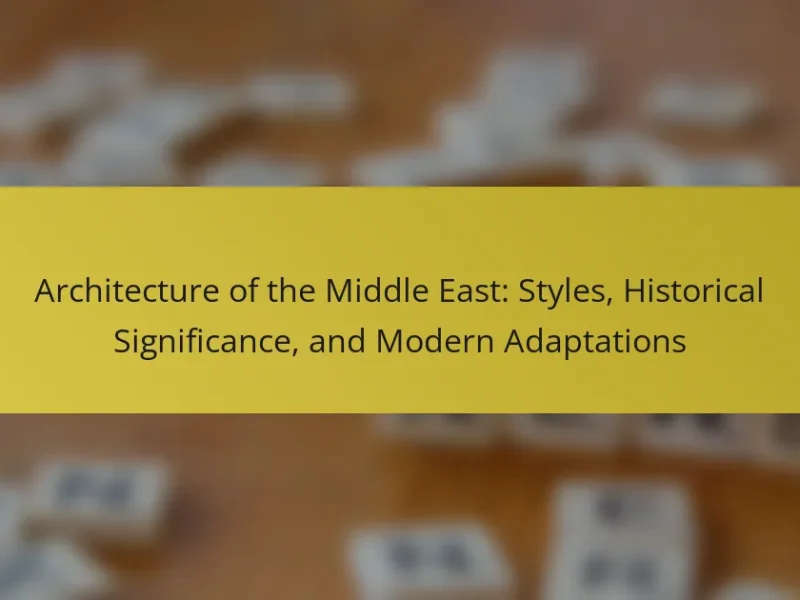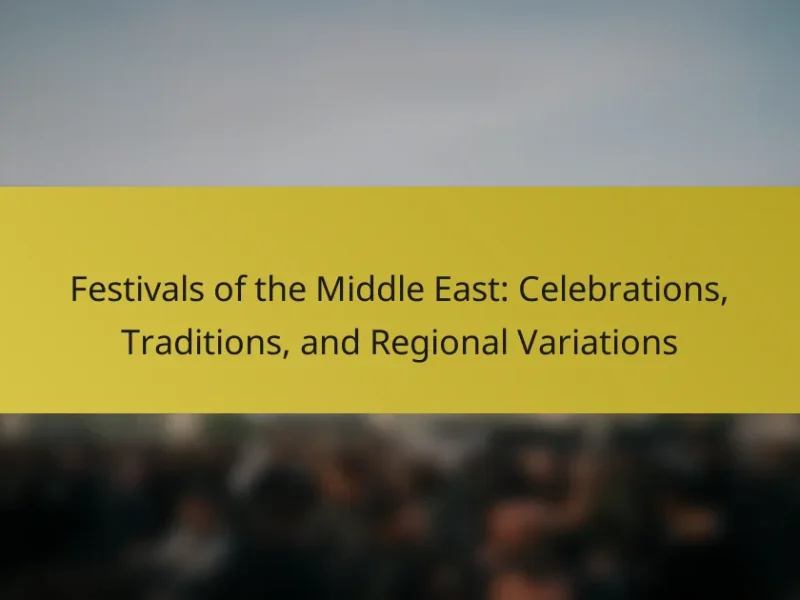
What is the Influence of Islamic Art on Global Aesthetics?
Islamic art has significantly influenced global aesthetics through its intricate patterns, vibrant colors, and unique calligraphy. The geometric designs and floral motifs are often used in various cultures, reflecting a blend of [censured] and beauty. This art form promotes a sense of harmony and balance, which many modern artists and designers adopt. Notably, the use of arabesques has inspired contemporary architecture and interior design worldwide. The historical spread of Islamic art during the Golden Age facilitated cross-cultural exchanges. This resulted in the integration of Islamic artistic elements into European Renaissance art. The impact is evident in the works of artists like M.C. Escher, who drew inspiration from Islamic tessellations. Overall, Islamic art continues to shape aesthetic principles across diverse cultures today.
How has Islamic Art evolved over time?
Islamic Art has evolved significantly over time, reflecting cultural, political, and technological changes. Initially, Islamic Art emerged in the 7th century with the advent of [censured]. Early works featured geometric patterns, calligraphy, and floral motifs, avoiding figurative representation due to religious beliefs. The Abbasid period saw the development of intricate tile work and architectural innovations, such as domes and minarets. The Ottoman Empire further enriched Islamic Art with grand palaces and detailed ceramics. The influence of trade introduced diverse styles and materials, blending local traditions with Islamic aesthetics. In modern times, Islamic Art continues to adapt, incorporating contemporary techniques while honoring traditional forms. This evolution illustrates the dynamic nature of Islamic Art across different eras and regions.
What historical events shaped the development of Islamic Art?
The development of Islamic Art was shaped by several key historical events. The rise of [censured] in the 7th century established a new cultural and artistic framework. The Umayyad Caliphate (661-750) expanded Islamic territories, facilitating cultural exchange. The Abbasid Caliphate (750-1258) promoted arts and sciences, leading to significant advancements in architecture and calligraphy. The Crusades (1095-1291) introduced Western influences to the Islamic world. The Ottoman Empire (1299-1922) further blended various artistic traditions, creating unique styles. The Safavid dynasty (1501-1736) in Persia also contributed to the richness of Islamic visual culture. Each of these events played a crucial role in the evolution of Islamic Art, influencing its themes, techniques, and aesthetics.
How did trade routes influence the exchange of artistic ideas?
Trade routes significantly influenced the exchange of artistic ideas by facilitating cultural interactions. These routes connected diverse civilizations, allowing for the movement of artists and artisans. As people traveled, they shared techniques, materials, and styles. For instance, the Silk Road enabled the flow of Islamic art into Asia and Europe. This exchange led to the blending of motifs and design principles. Evidence shows that Persian miniatures influenced European Renaissance art. Additionally, trade brought new materials, such as lapis lazuli, enhancing artistic expression. Overall, trade routes were vital for the cross-pollination of artistic traditions.
What are the key characteristics of Islamic Art?
Islamic Art is characterized by intricate geometric patterns, arabesques, and calligraphy. These elements reflect a deep appreciation for symmetry and order. Geometric patterns often serve as a unifying theme across various forms of Islamic Art. Arabesques, which are flowing, floral designs, symbolize the infinite nature of creation. Calligraphy is considered the highest form of artistic expression, often featuring verses from the Quran. The use of vibrant colors and rich materials, such as gold and ceramics, enhances the visual appeal. Islamic Art avoids the depiction of human figures in religious contexts, focusing instead on abstract and ornamental designs. This art form spans various mediums, including architecture, textiles, and manuscripts. Historical examples, like the Alhambra and the Taj Mahal, illustrate these key characteristics effectively.
What are the common themes and motifs found in Islamic Art?
Common themes and motifs in Islamic art include geometric patterns, calligraphy, and arabesques. Geometric patterns often symbolize the infinite nature of Allah. They are meticulously designed and can be found in various forms, such as tiles and textiles. Calligraphy is highly revered, often featuring verses from the Quran. It serves both decorative and spiritual purposes, emphasizing the importance of the written word in [censured]. Arabesques consist of intricate floral and vegetal designs. They represent the beauty of nature and the divine creation. These motifs are prevalent in architecture, ceramics, and manuscripts. Together, they create a distinct aesthetic that reflects Islamic values and beliefs.
How does calligraphy play a role in Islamic Art?
Calligraphy is a central element in Islamic art. It serves as a primary means of expressing religious devotion and cultural identity. Islamic calligraphy often features verses from the Quran, enhancing the spiritual significance of artworks. The intricate designs and styles of calligraphy vary across regions, reflecting diverse cultural influences. Calligraphy is not only decorative but also conveys messages and stories. It has historically been used in architecture, manuscripts, and ceramics. The emphasis on calligraphy arises from aniconism in Islamic tradition, where figurative representations are discouraged. This makes calligraphy a vital form of artistic expression within the Islamic world.
How does Islamic Art impact contemporary global aesthetics?
Islamic Art significantly influences contemporary global aesthetics through its intricate designs and patterns. These elements inspire modern artists and architects worldwide. The use of geometric patterns is particularly notable. Such patterns promote a sense of harmony and balance. Additionally, calligraphy from Islamic Art has been integrated into various design fields. This integration enhances visual communication in contemporary contexts. The emphasis on symmetry and repetition in Islamic Art also informs modern design principles. Many contemporary artworks reflect these traditional aesthetics, creating a dialogue between past and present. Evidence of this influence can be seen in public spaces and commercial designs globally.
What elements of Islamic Art are integrated into modern design?
Geometric patterns are a prominent element of Islamic art integrated into modern design. These intricate designs often feature repeating motifs and symmetrical shapes. Modern architecture frequently incorporates these patterns in facades and interior decorations. Calligraphy is another significant feature, often used in branding and graphic design. The use of arabesques, which are flowing, intertwining floral designs, can be seen in textiles and wallpapers today. Color palettes inspired by Islamic art, such as rich blues and golds, are also prevalent in contemporary design. The influence of Islamic art is evident in various design fields, including fashion and product design. This integration reflects a growing appreciation for cultural diversity and historical aesthetics in modern creativity.
How do artists today draw inspiration from Islamic Art traditions?
Artists today draw inspiration from Islamic Art traditions through intricate geometric patterns, calligraphy, and vibrant color palettes. They often incorporate these elements into contemporary works, blending tradition with modern techniques. For example, many artists study the mathematical principles behind Islamic geometric designs, applying them in new contexts. The use of arabesque motifs can be seen in various mediums, from painting to architecture. Artists also explore the spiritual and cultural significance of Islamic art, creating pieces that reflect these themes. Notable exhibitions showcase how these influences manifest in global art scenes. Research indicates that the revival of interest in Islamic aesthetics has led to a fusion of styles in contemporary art. This cross-pollination enriches the artistic landscape, demonstrating the enduring impact of Islamic traditions.
What techniques are commonly used in Islamic Art?
Islamic art commonly employs techniques such as calligraphy, geometric patterns, and arabesques. Calligraphy is often used to convey religious texts and is highly stylized. Geometric patterns create intricate designs that reflect mathematical precision. Arabesques feature flowing, intertwining floral motifs. These techniques emphasize symmetry and repetition. They are integral to the aesthetic appeal of Islamic art. Historical examples include the Alhambra in Spain and the Blue Mosque in Turkey. These techniques have influenced various art forms worldwide.
What are the primary methods of tile work in Islamic Art?
The primary methods of tile work in Islamic Art include cuerda seca, mosaic, and azulejos. Cuerda seca involves using a wax-like substance to separate different colored glazes. This technique creates intricate patterns and designs. Mosaic tile work consists of small pieces of ceramic or glass arranged to form a larger image. It is often used in architectural decoration. Azulejos are painted tin-glazed ceramic tiles, commonly found in Spain and Portugal. They often depict historical or religious scenes. These methods showcase the diversity and complexity of tile work in Islamic Art.
How is geometric design utilized in Islamic Art?
Geometric design is a fundamental aspect of Islamic art. It is used to create intricate patterns that symbolize the infinite nature of creation. These designs often incorporate repetitive motifs, showcasing mathematical precision and symmetry. Islamic geometric patterns are typically found in architecture, textiles, and ceramics. They serve both decorative and spiritual purposes. The use of geometric design reflects the Islamic belief in unity and order in the universe. Historical examples include the Alhambra in Spain and the Great Mosque of Samarra in Iraq. These sites exhibit complex geometric designs that enhance their aesthetic appeal and convey deeper meanings.
In what ways does Islamic Art influence other cultures?
Islamic art influences other cultures through its intricate designs, geometric patterns, and calligraphy. These elements have been adopted in various artistic traditions worldwide. For instance, the use of arabesques can be seen in European Renaissance art. The spread of Islamic art occurred during the expansion of the Islamic Empire, which facilitated cultural exchanges. Architectural techniques, such as the use of domes and minarets, inspired structures in regions like Spain and India. The incorporation of Islamic motifs is evident in textiles and ceramics across Asia and Africa. Additionally, the emphasis on non-figurative art has shaped modern abstract art movements. This cross-cultural impact highlights the enduring legacy of Islamic artistic principles.
How has Islamic Art impacted Western art movements?
Islamic Art has significantly influenced Western art movements through its distinct styles and techniques. The introduction of intricate geometric patterns and arabesques inspired European artists during the Renaissance. This influence can be seen in the works of artists like Albrecht Dürer, who incorporated Islamic motifs into his prints. Furthermore, the use of vibrant colors and elaborate tile work in Islamic architecture inspired the decorative arts in Europe. The exchange of ideas during the Crusades facilitated the spread of these artistic concepts. Additionally, Islamic calligraphy and manuscript illumination impacted Western book arts, leading to new styles in typography and decoration. The fascination with Eastern aesthetics in the 19th century, known as Orientalism, further demonstrates this influence. Overall, the cross-cultural interactions have enriched Western art with diverse techniques and aesthetic principles derived from Islamic traditions.
What examples exist of cultural exchange through Islamic Art?
Cultural exchange through Islamic Art is exemplified by the incorporation of motifs and techniques from various cultures. One significant example is the use of geometric patterns, which originated in Islamic art and influenced European Renaissance artists. The Alhambra in Spain showcases the blend of Islamic art with local Spanish styles. Additionally, Persian miniatures influenced Mughal painting in India, demonstrating cross-cultural artistic dialogue. The spread of tile work techniques from the Islamic world to Europe is another notable instance. The silk trade routes facilitated the exchange of artistic ideas and materials between the East and West. These examples highlight the dynamic interactions and mutual influences between Islamic art and other cultures.
What are some practical applications of Islamic Art techniques today?
Islamic art techniques are applied in various contemporary fields today. These techniques influence architecture, interior design, and graphic design. In architecture, geometric patterns and arabesque motifs are integrated into modern buildings. Interior designers use Islamic tile work to create visually striking spaces. Graphic designers incorporate calligraphy into branding and digital art. Textile designers draw inspiration from traditional Islamic patterns for fashion and home decor. These applications reflect the enduring legacy of Islamic art in modern aesthetics.
The main entity of this article is Islamic Art and its influence on global aesthetics. The article explores the intricate characteristics of Islamic Art, including geometric patterns, calligraphy, and arabesques, and how these elements have shaped artistic principles across diverse cultures. It discusses the historical evolution of Islamic Art, key events that influenced its development, and the techniques used in its creation, such as tile work and geometric design. Additionally, the article examines the cross-cultural exchanges facilitated by trade routes and how contemporary artists integrate Islamic Art traditions into modern design, highlighting its ongoing impact on global aesthetics.


